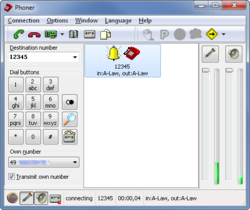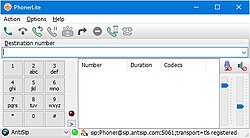| Phoner | |
|---|---|
| | |
 Phoner on Windows 7 | |
| Developer | Heiko Sommerfeldt |
| Initial release | February 1998 [1] |
| Stable release | 3.23 / March 5, 2021 [2] |
| Operating system | Microsoft Windows |
| Size | 4.79 MB |
| Available in | 12 languages [2] |
List of languages English, German, Dutch, Italian, Greek, Czech, Bulgarian, French, Spanish, Persian, Portuguese, Polish | |
| Type | VoIP |
| License | Freeware |
| Website | phoner |
| PhonerLite | |
|---|---|
| | |
 PhonerLite on Windows 10 | |
| Initial release | 1 June 2005 |
| Stable release | 3.33 / October 10, 2025 [3] |
| Size | 6.70 MB |
| Available in | 10 languages [4] |
List of languages Arabic, Czech, English, French, German, Italian, Polish, Portuguese, Russian, Spanish, Turkish | |
| Website | lite |
Phoner and PhonerLite are softphone applications for Windows operating systems available as freeware. Phoner is a multiprotocol telephony application supporting telephony via CAPI, TAPI and VoIP, while PhonerLite provides a specialized and optimized user interface for VoIP only. Beside the different user interface focus both programs share the same code base.
Contents
Both programs use the Session Initiation Protocol for VoIP call signalisation. Calls are supported via server-based infrastructure or direct IP to IP. Media streams are transmitted via the Real-time Transport Protocol which may be encrypted with the Secure Real-time Transport Protocol (SRTP) and the ZRTP security protocols. Phoner provides as well an interface for configuring and using all supplementary ISDN services provided via CAPI and thus needs an ISDN terminal adapter hardware installed in the computer.
Both programs support IPv4 and IPv6 connections by using UDP, TCP and TLS.